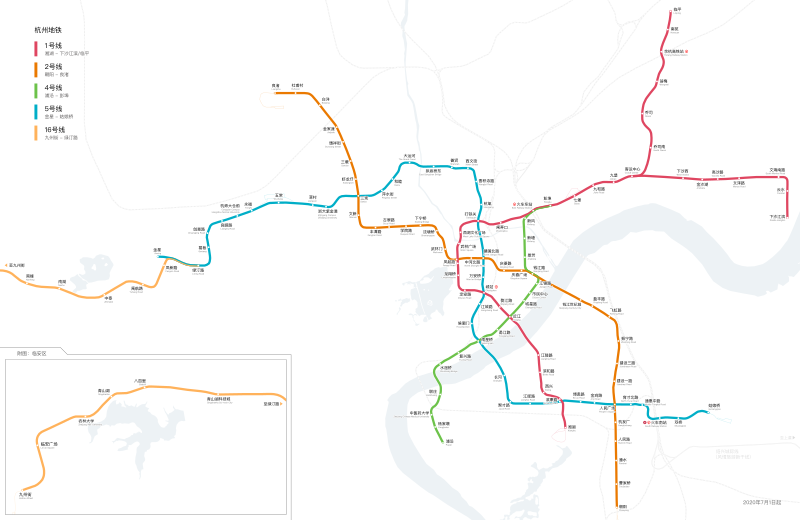Hangzhou Metro
Hangzhou Metro (Chinese: 杭州地铁) is a rapid transit system that serves Hangzhou in Zhejiang province, China. The system opened on November 24, 2012.[3] It is the 17th city in China to operate a rapid transit system.
 | |||
| Overview | |||
|---|---|---|---|
| Owner | City of Hangzhou | ||
| Locale | Hangzhou, Zhejiang, China | ||
| Transit type | Rapid transit | ||
| Number of lines | 5 | ||
| Number of stations | 135 | ||
| Daily ridership | 931,233 (2017 avg.)[1] 1,727,000 (2018 Peak)[2] | ||
| Operation | |||
| Began operation | November 24, 2012 | ||
| Operator(s) | Hangzhou Metro Corporation (Line 2, Line 4, Line 16) MTR Corporation (Hangzhou) (Line 1, Line 5) | ||
| Technical | |||
| System length | 206 km (128 mi) | ||
| Track gauge | 1,435 mm (4 ft 8 1⁄2 in) | ||
| |||
| Hangzhou Metro | |||||||||||
|---|---|---|---|---|---|---|---|---|---|---|---|
| Simplified Chinese | 杭州地铁 | ||||||||||
| Traditional Chinese | 杭州地鐵 | ||||||||||
| |||||||||||
Network

| Line | Terminals (District) |
Commencement | Newest Extension |
Length km |
Stations | Operator | |
|---|---|---|---|---|---|---|---|
| 1 | Xianghu (Xiaoshan) |
Xiasha Jiangbin (Jianggan) Linping (Yuhang) |
2012 | 2015 | 53.6 | 34 | |
| 2 | Chaoyang (Xiaoshan) |
Liangzhu (Yuhang) |
2014 | 2017 | 43.3[4] | 33 | |
| 4 | Pengbu (Jianggan) |
Puyan (Binjiang) |
2015 | 2018 | 20.8 | 18 | |
| 5 | Jinxing (Yuhang) |
Guniangqiao (Xiaoshan) |
2019 | 2020 | 53.9 | 38 | |
| 16 | Lvting Road (Yuhang) |
Jiuzhou Street (Lin'an) |
2020 | 35.1[5] | 12 | ||
| Total | 206 | 135 | |||||
There are currently 5 lines in operation. Line 1 is an arc-shaped line, begins in Xiaoshan, stretches across downtown Hangzhou[6] after crossing the Qiantang River and ends in Xiasha, with a branch line branching off the main line at Coach Center station and ending in Linping. Line 2 links the Xiaoshan Industrial Park in the southeast with the city center and Xihu District in the northwest. Line 4 complements Line 1 in downtown Hangzhou, stretching in a north-south direction from Pengbu to Puyan.
The Hangzhou Metro has the only metro system map in China whose first seven lines follow the hue order of the rainbow colors. [7]
History
Initial plans
The planning for a metro system in the city started in the 1990s and was about to start construction works in September 2003, but the State Council suspended construction works due to increasing costs. The state council approved the construction and operation of a rapid transit system by the Hangzhou Subway Group Co. Ltd in Hangzhou on June 5, 2005.[8] The preliminary design for the first line, Line 1, was approved on January 11, 2007 by the Development and Reform Commission after four days of study. It would be 47.97 km long, of which 41.36 km is underground, 6.14 km elevated, and 0.47 km at grade.[9]
Construction


Construction of the first phase of Hangzhou Metro Line 1 began on March 28, 2007, with subsequent phases beginning later in that year. The first phase included three underground stations in Qianjiang New City. Jiubao East Station is the biggest station along Line 1 and will be a hub for the future metro system and other forms of public transport.[6] The funding of Line 1 came from both the city government and the banks, with 10.2 billion yuan and 5 billion yuan respectively. The first phase construction was estimated to be 45 billion yuan.[8]
In January 2009, it was announced that MTR Corporation would invest in a 22 billion-yuan ($3.2 billion) / 25-year / 49% share joint venture with the Hangzhou government to operate Line 1 of the metro.[10]
The first section of Line 4 opened for trial operation on February 2, 2015.[11]
In December 2016, the National Development and Reform Commission approved the planning for 10 lines, including extensions to the three existing lines, scheduled to open in time for the 2022 Asian Games.[12] By then the Hangzhou Metro network is projected to be 446 km long.[13] As of 2018 there are over 300 km of subway lines under construction in Hangzhou,[14] including a line (Hangshao line) to neighboring Shaoxing which is building its own metro system, Shaoxing Metro.[15]
Accident
On November 15, 2008, a 75-metre (250 ft) section of the tunnel near Fengqing Avenue in Xiaoshan District collapsed while under construction,[16] killing 17 people.[17]
Future expansions
| Years | Lines | Section | Terminals | Length
(km) |
Stations | Notes & References | |
|---|---|---|---|---|---|---|---|
| 2020 | 1 | Phase 3 | Xiasha Jiangbin | Xiaoshan International Airport | 11.5 | 5 | |
| 6 | Phase 1 | Shuangpu | Fengbei | 27.0 | 19 | [18][19] | |
| Phase 2 | Fengbei | Jichang Road | 8.3 | 5 | |||
| Fuyang section | Meiyuanxiangshan | Guihua Road | 23.15 | 11 | [20][21] | ||
| 2021 | 4 | Phase 2 | Pengbu | Zijingang Road | 23.9 | 15 | [22][23][24] |
| 7 | Wushan Square | Jiangdong'er Road | 45.0 | 23 | [22][25][26] | ||
| 8 | Phase 1 | South Wenhai Road | Jiangdong | 17.2 | 8 | [22][27][26] | |
| 9 | Phase 1 | Sijiqing | Changda Road | 29.5 | 21 | Line 1's branch (Coach Center to Linping) will be merged with Line 9 when it opens, so the 7 stations on it and their length are all counted.[28] | |
| 2022 | 3 | Main Line | West Wenyi Road | Xingqiao Road | 43.8 | 30 | [22][29][30][31] |
| Branch | Xiaoheshan | Baijiayuan Road | 8.4 | 5 | The branch line will become Line 14 in the future.[22][30] | ||
| 5 | Phase 2 Adjustment section | Jinxing | Laoyuhang | 2.03 | 1 | ||
| 10 | Phase 1 | Zhejiang University | Xinxing Road | 11.2 | 12 | [22][32][28] | |
| Airport Express | Tiaoxi | Jingjiang | 58.5 | 15 | [33] | ||
| TBA | 11 | TBC | TBC | TBC | TBA | TBA | |
| 12 | TBC | TBC | TBC | TBA | TBA | ||
| 13 | TBC | TBC | TBC | TBA | TBA | ||
| 14 | TBC | TBC | TBC | TBA | TBA | ||

References
- "2017年统计报告". 中国城市轨道交通协会. April 19, 2018. Retrieved April 28, 2018.
- 交通运输部网站. "端午期间杭州市旅客出行需求提升明显 地铁运输再创新高". Sina. Retrieved June 20, 2018.
- "本网快讯:杭州地铁时代即将来临 1号线24日开通". Archived from the original on June 17, 2013. Retrieved November 22, 2012.
- "今天17时,地铁2号线全程开通 从头坐到尾只需77分钟". December 27, 2017.
- "杭州地铁16号线开通在即 余杭到临安不到38分钟". April 9, 2020.
- Kat Jiang, "Hangzhou to build metro system, Shanghai Daily, 2007-03-01
- 七色彩虹! 杭州地铁每条线颜色是怎么出炉的?看揭秘
- Tang Fuchun, Hangzhou Subway Planning Approved, china.org.cn, 2005-06-16
- "Design of Hangzhou Metro Line No.1 Brings Convenience to Passengers". January 11, 2007. Archived from the original on May 22, 2011.
- "MTR to Operate, Invest in $3.2 Billion Subway in Eastern China". bloomberg.com. January 16, 2009. Retrieved April 30, 2015.
- "experimental operation on Metro Line 4 first section, February 2". hangzhou.gov.cn/ (in Chinese). February 2, 2015. Archived from the original on February 4, 2015. Retrieved February 4, 2015.
- "杭州地铁三期10条线路获批 计划亚运会前建成". December 21, 2016.
- "[浙江]杭州地铁2号线西北段开通 22分钟城西飞驰到城东(图)". news.sina.com.cn. Retrieved July 6, 2017.
- "穩增長 內地掀新一波城市軌道建設熱 - 香港經濟日報 - 中國頻道 - 經濟". china.hket.com. Retrieved August 26, 2018.
- "无缝对接!绍兴地铁1号线与杭州地铁5号线连上了!". www.sohu.com. Retrieved January 24, 2019.
- http://www.shanghaidaily.com/article/?id=380858&type=National
- http://www.chinapost.com.tw/china/local-news/other/2008/11/26/184928/Deaths-from.htm
- "地铁6号线一期通过工程可行性评审 2019年通车-杭网宽频-杭州网". hztv.hangzhou.com.cn. Retrieved December 24, 2016.
- "杭州地铁6号线 - 杭州地铁生活网". www.0571dt.cn. Retrieved December 24, 2016.
- 曹姣娜. "滚动:杭州至富阳城际铁路工程正式开工 在美院象山站可与地铁6号线换乘-实时新闻-杭州日报". news-hzrb.hangzhou.com.cn. Archived from the original on January 14, 2017. Retrieved December 24, 2016.
- "杭州至富阳城际铁路工程环境影响评价第二次公示_公告栏目_新闻中心_中冶赛迪重庆环境咨询有限公司". www.cisdiec.com. Retrieved December 24, 2016.
- , Line 4 (Hangzhou Metro).
- , Line 7 (Hangzhou Metro).
- , Line 8 (Hangzhou Metro).
- , Line 3 (Hangzhou Metro).
- (in Chinese)52㎞、34站横穿市区 难产多年杭州地铁3号线年底开工
- , Line 10 (Hangzhou Metro).
- 15个站点全部开工 2022年建成 杭州机场轨道快线列入省重点建设项目. November 15, 2019.
External links
| Wikimedia Commons has media related to Hangzhou Metro. |
- Hangzhou Metro (official site) (in Chinese)
- Urbanrail page on the Hangzhou Metro